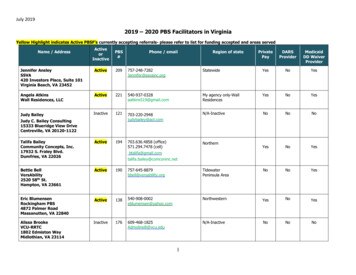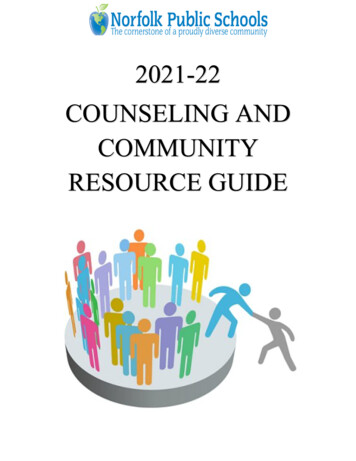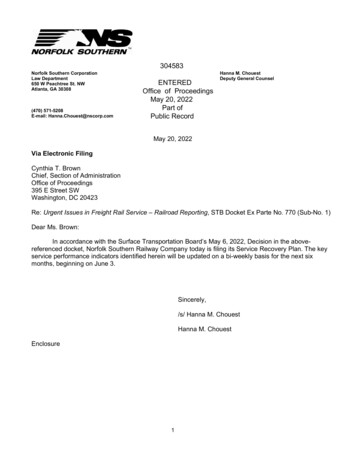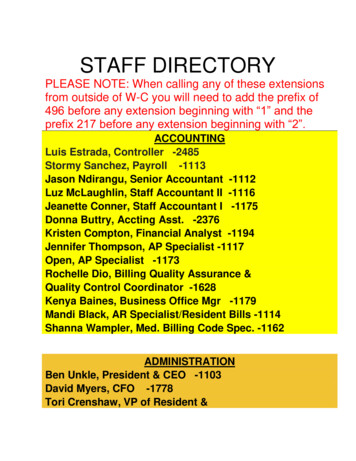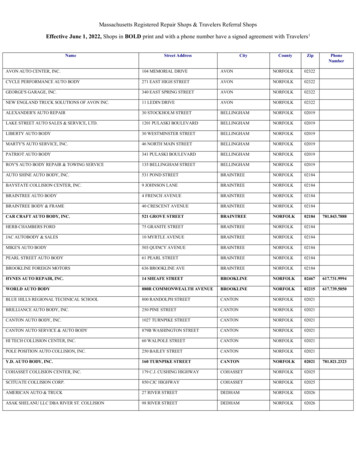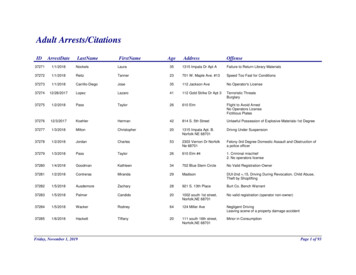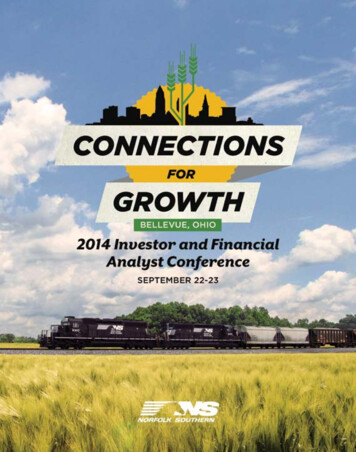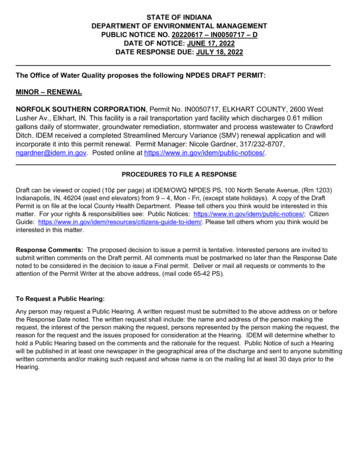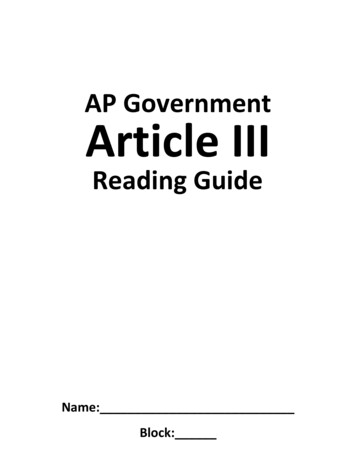
Transcription
AP GovernmentArticle IIIReading GuideName:Block:
AP Government and Politics-The Judiciary Chapter 91. What does the Constitution say about the Supreme Court? What did the Founding Fathersthink about the Supreme Court? –Look at the pictureDefine lame duck-please look up President Obama’s last selection for a Supreme CourtJustice and what happened. Do you agree or disagree with Mitch McConnell’s on-2192482. Discuss the impact Marbury v. Madison (1803) had on Supreme Court authority. Whatimportant power did it establish for the court?3. What does judicial review mean? Explain in your own words4. A court’s jurisdiction refers to:original jurisdictionappellate jurisdiction5. List the types of federal courts from lowest to highest: Draw a picture of the Federal andState court system
6. What is the difference between appellate and original jurisdiction?7. What is the difference between criminal and civil law?8. Explain constitutional courts and Legislative courts9. What is a brief?10. Describe precedent and explain its significance in the US court system.PrecedentLawyers for both sides of a case look to cases that have been decided in the past that bolstertheir current arguments.For each pair of cases below describe how precedent could be used as an argument.You are a lawyer for the students working on the school newspaper in the case HazelwoodSchool District v. Kuhlmeier. How might you try to use the decision in Tinker v. Des Moinesas precedent?
You are a lawyer representing the school in the case TLO vs. New Jersey. Your opponent(TLO’s lawyer) uses Mapp vs. Ohio as precedent. How would you respond – what would yousay is different about that case?You are a lawyer representing Gideon in Gideon v. Wainwright. How might you use Gitlow vNew York as precedent? Be careful because the two cases are different but do sharesomething in common.8. (Define) stare decisis:9. Define senatorial courtesy:10. List (6) factors in selecting a Supreme Court nominee:11. What are the steps that nominees must go through to make it onto the Supreme Court?12. Who are the two Justices that had the hardest time getting on the court in recent years?13. How do interest groups participate in the Judicial Process?
14. What is the court doing when it issues a writ of certiorari?15. Define the rule of four.16. Describe the typical Supreme Court law clerk. What role do they play in hearing anddeciding cases?17. Identify and state the significance of the Solicitor General.18. Is a case more likely to be heard by the Supreme Court if there is a strong interest groupbehind it? Don’t just write yes or no-answer the question and back it up ):19. Identify and state the significance of amicus briefs.20. How much time do lawyers get to present their case to the Supreme Court?21. How are the conferences (meeting of the justices behind closed doors) different underChief Justice Roberts than they were under his predecessor(Chief Justice Rehnquist).(Define) judicial restraint –(Define) judicial activism –22. In 2006, the US Senate voted unanimously not to change the Voting Rights Act of 1965.If the Supreme Court changes the law in the next few months, is that an example of judicialrestraint or judicial activism?(Define) strict constructionist –The Roe v. Wade (1973) decision upheld a woman’s right to an abortion by virtue of a rightto privacy. However, a right to privacy is not mentioned in the Constitution. Is this decision
an example of strict construction or loose construction?23. Describe 2 ways the Supreme Court is insulated from public opinion. (This answer is notin the book so you will need to come up with your own theories/ideas).24. Describe 3 factors that keep the Supreme Court from deviating too far from publicopinion?25. How does the Supreme Court create policy?26. Give an example of a case where the Supreme Court overruled itself.28. Explain judicial implementation. Explain the difference opinions written by the court.Concurring opinions, majority opinions, plurality opinions, dissenting opinions29. Why is Judicial Branch considered the weakest branch? Federalist 7827. What did Andrew Jackson mean when he said about the Supreme Court, “John Marshallhas made his decision; now let him enforce it.”Multiple Choice1) In which decision did the Supreme Court declare that it could exercise judicial review overacts of the national government? A) Marbury v. Madison B) Martin v. Hunter’s Lessee C)McCulloch v. Maryland D) Gibbons v. Ogden E) The People v. Larry Flint
2) All of the following are checks on the judiciary EXCEPT A) Congress can alter thejurisdiction of the Supreme Court. B) Court decisions can be reversed by constitutionalamendment. C) Congress can pardon those convicted by the courts. D) Judges can beimpeached and removed from office. E) The president appoints judges with the “advice andconsent” of the Senate.3) The Judiciary Act of 1789 A) created the Supreme Court and its jurisdictions. B)established the state court structures. C) established the basic structure of the federal courtsystem. D) granted the Supreme Court the power of judicial review. E) required the states toabide by the Bill of Rights.4) What does the Eleventh Amendment say? A) A citizen of one state cannot sue anotherstate in federal court. B) Congress has the power of judicial review. C) The Supreme Courthas the power of judicial review. D) Congress can establish a national bank. E) TheSupreme Court “shall render Judgment in all Cases arising from violations of theConstitutions of the Various States.”5) The Supreme Court typically has A) trial jurisdiction. B) penal jurisdiction. C) originaljurisdiction.D) appellate jurisdiction. E) executive jurisdiction.6) Courts with appellate jurisdiction typically A) review the factual record of a lower courtfor mistakes. B) determine factual matters in the case involved. C) review the legalprocedures of a lower court for mistakes. D) hear evidence regarding the facts of the case. E)rubber stamp the decisions of trial courts.10) Which of the following lists of federal courts is in order from the lowest court to thehighest court? A) district courts; Supreme Court; courts of appeals B) courts of appeals;district courts; Supreme Court; legislative courts C) Supreme Court; courts of appeals;district courts D) district courts; courts of appeals; Supreme Court E) municipal courts;country courts; state courts; federal courts11) In court rulings, a reliance on past decisions or precedents to formulate decisions on newcases is called A) stare decisis. B) solicitation. C) strict construction. D) certiorari. E) fiatlux.12) Who is most likely to write an amicus brief? A) Congress B) the chief justice C) thechief justice if he is in the majority; the associate justice with the most seniority if the chiefjustice is in the minority D) the media E) interest groups13) The idea that judges should use their power broadly to further justice is called A) staredecisis. B) original intent. C) judicial restraint. D) judicial activism. E) conservativerestoration.
True/False 14) The bulk of the judicial work in the federal system takes place in theSupreme Court. 15) The Constitution sets the number of justices on the Supreme Court atnine 16) Politics permeate the selection process for judges and justices.OK-can you answer all the review questions on page 220 and define all the words?Civil Liberties-Chapter 41. Define civil liberties:2. Define civil rights:3. Summarize the difference between civil liberties and civil rights:4. Define 14th Amendment’s due process clause:5. Describe how the Gitlow v. New York (1925) changed the way that the Bill of Rights appliedto state governments.6. Define selective incorporation and explain why the word “selective” is used in this term:
7. Define due process rights:8. Identify the right that each of the following cases incorporated:Gitlow v. New York (1925) Near v. Minnesota (1931) DeJonge v. Oregon (1937) Cantwell v.Connecticut (1940) McDonald v. Chicago (2010)(look up)Mapp v. Ohio (1961) Gideon v. Wainwright (1963) Duncan v. Louisiana (1968) Griswold v.Connecticut (1965)9. What are three essential characteristics of fundamental freedoms?9. Define First Amendment:10. Define establishment clause: -How does the Lemon v. Kurtzman case help to deal with issuesof relating to this clause?11. Define free exercise clause:12. Why is polygamy not allowed under the free exercise clause?13. What did the Supreme Court decide in Engel v. Vitale?The free exercise clause of the First Amendment has challenged the Supreme Court andlawmakers for decades. Why do you think it is such a difficult topic to legislate or rule upon?How have the following free exercise questions been answered by laws or court decisions: lookup and give court case Rights for conscientious objectors:
Prisoners practicing religion while detained: Use of illegal drugs in religion: Requiring health plans to include coverage for contraceptives:14. Define prior restraint:15. Explain how the clear and present danger test was used to suppress even political speech.16. Describe how this test was used in the Schenk v. U.S.17. Explain how the direct incitement test would have impacted the sedition cases.Protected Speech and Press Cases that relate with brief descriptionLimiting Prior RestraintSymbolic SpeechHate SpeechUnprotected Speech and Press Cases or rulings that relate with brief descriptionLibel and SlanderFighting WordsObscenity
18. DeJonge v. Oregon incorporated which portion of the First Amendment?19. Why did the Second Amendment please the Anti-Federalists during ratification?20. What issue lead to the explosion of organized crime in the 1920’s and 30’s?21. How did congress respond in 1934 and what case upheld the legality of the law?22. Explain D.C. v Heller and McDonald v. City of Chicago 2010 Court case that incorporatedthe Second Amendment.23. Define the following due process terms: -writs of habeas corpus-YOUR WORDS-ex post facto laws -bills of attainder –grand jury24. What is the 4th Amendment?25. How has the 4th Amendment been interpreted when it comes to drug testing? Give examples.26. Under what circumstances are warrantless searches able to occur?27. What is the 5th Amendment?28. Who was Miranda?29. Define Miranda rights:30. Define double jeopardy:31. Define the exclusionary rule:32. Why was it necessary to create the exclusionary rule?33. How does this rule apply to the case of Mapp v. Ohio (1961)?34. Describe how the case of Gideon v. Wainwright changed the application of the 6thAmendment’s right to counsel.35. How have impartiality requirements been interpreted over time and what does the court sayabout peremptory challenges?
36. Why did the Court say capital punishment was unconstitutional according to Furman v.Georgia? What did the Georgia lawmakers do in response? What amendment?37. What two key classes of people are exempted from the death penalty?38. House vs Bell recognized the power of evidence.39. What power do Governors have when it comes to those on death row?(Define) right to privacy and where is it in the Constitution?40. What Connecticut law was overturned in the Supreme Court case Griswold v. Connecticut(1965)?41. Roe v. Wade (1973) challenged a Texas law that allowed abortion in very limitedcircumstances. What did the Texas law say?42. Planned Parenthood of Southeastern Pennsylvania v Case43. What was the significance of the Lawrence v. Texas case towards gay rights?44. Obergefell v. Hodges45. Explain how the US Patriot Act has affected civil liberties including- First Amendment,Fourth Amendment and Due Process46. Describe the following Supreme Court Justices-Warren Burger and Earl WarrenExplain how and why the NAACP uses litigation as an approach to getting laws changed andprotecting minorities.47. (Define) Thirteenth Amendment:
48. (Define)Black Codes:49. What did the Fourteenth Amendment guarantee to all free slaves?50. (Define) Fifteenth Amendment:51. (Define) The Civil Rights Act of 1875:52. (Define) Jim Crow laws:53. (Define) Poll taxes/What amendment stopped poll taxes54. (Define) Grandfather clause55. What conclusion did the Supreme Court reach in the case Plessy v. Ferguson (1896)?What case in the 1950s would overturn the decision made in the Plessy case?56. (Define) suffrage movement:57. (Define) Nineteenth Amendment:58. (Define) Brown v. Board of Education (1954)/Who was the lawyer59. (Define) equal protection clause/where is it found in the Constitution?60.What specific topics did the Civil Rights Act of 1964 address:61. What is the difference between de jure discrimination and de facto discrimination.62. (Define) Equal Rights Amendment:63. Equal Employment Opportunity Commission-What does it do64. NOW(don’t just give me what is stands for)65. Strict scrutiny
66. (Define) Title IX:66. What gains have been made (in terms of gaining more rights) by the following groups:Hispanic Americans –Native Americans –Gays and Lesbians –Disabled Americans –67. (Define) affirmative action:68. Regents of the University of California v Bakke69. What did the Supreme Court decide regarding affirmative action in Grutter v. Bollinger(2003)?70. What issues has Wal-Mart faced regarding workplace discrimination?. *** (Go online to answer the questions below) Who is Lilly Ledbetter?What company did she work for?How is her case relevant to this chapter?Video 19: Structure of the Court SystemWhy is the American Court system hierarchical?1.2.How many federal US District Courts are there?3.How many federal appeals courts are there?4.What are the four scenarios where the federal courts have original jurisdiction?5.How does a case get to the Supreme Court?6.When does the Supreme Court have original jurisdiction?7.What is the criteria for an appeals case to make it to the Supreme Court?8.What are the cases the courts will almost always take?Video 20: Supreme Court of the United States Procedure1.What is the first thing you need in order to reach the Supreme Court?
2.What is a writ of certiorari?3.What is the role of the solicitor general?4.What is the purpose of the cert pool?5.Define the rule of four?6.What is a legal brief and what is its purpose?7.Define the role of petitioner and respondent?8.What is the purpose of an amicus curiae brief?9.What is a majority opinion, single majority opinion, a remand, a holding occurring opinion, and adissentingopinion?10.Provide a procedural summary of what it takes for a case to get to the Supreme Court.Video 21: Judicial Review1. What is the official definition of judicial review?2. What is appellate review?3. What does the court have the power to do (there are four) and give an example of each?4. Where does the court get the power of judicial review?
5. Why has this ruling stuck around? (make sure you reference stare decisis in youranswer) Does Judicial Review violate the principle of separation of powers?Video 22: Judicial Decisions1. In what ways are justices influenced2. Why is POTUS less influential than history to the justices of the Supreme Court3. How important is political party affiliation and political ideology in the selection process?4. The most important influence to a judge is their philosophical orientation, how so and whatare the two most important philosophies?5. What is judicial activism and what are the common characteristics associated with activistjudges?6. What is judicial restraint and what are the common characteristics associated with restraintjudges?7. How is originalism different than restraint?8. What key decisions were made during the activist judge period of Warren/Burger Court ofthe 1950s and 1970s?9. What decisions were made during the restraint judge period of Chief Justice Rehnquist of the1980s and 2000sWhat is the point Craig is trying to make when discussing Chief JusticeRoberts and his conservative nature and judicial restraintVideo 23: Civil Rights and Civil Liberties1. What is the difference between Civil Rights and Civil Liberties (not how I taught you todifferentiate between the two, but actually differences) ?2. What is a substantive liberty? Give an example3. What is a procedural liberty? Give an example4. Where do we look to find civil liberties?5. What was the ruling in Barron v. Baltimore? (summarize)6. What does the 14 Amendment create?th
7. Define selective incorporation. Give an example .8. What were the Framers scared of when it comes to rights and liberties?
Due Process of the LawThe passages that follow discuss the constitutional amendments that safeguard dueprocess of law. Use the list of words below to fill in the blanks.Words: exclusionary, criminal, accused, charges, self incrimination, jury, defense,warrant, legal counsel, double jeopardy, cruel and unusual, witnesses, bail, searches andseizures, grand jury, trial by juryFourth AmendmentThe Fourth Amendment protects citizens from unreasonable. This right is enforced in two ways.First police must have a valid in order to conduct a search. Second,illegally obtained evidence cannot be used in court because of therule.Fifth AmendmentThe Fifth Amendment protects the rights of citizens who have beenof a crime. It prohibits and, or forcing people to testify againstthemselves. Furthermore, it grants a person charged with a serious federal crime theright to a .Sixth AmendmentThe Sixth Amendment guarantees the right of citizens incases to a trial by . Individuals accused ofa crime also have the right to know what have been madeagainst them and the right to confront the testifying againstthem. The accused also have the right to call witnesses and theright to be represented in court by even if theyare unable to pay the legal fees.Seventh AmendmentThe Seventh Amendment guarantees the right of civil suits heard in federal court toa if the case exceeds more than twenty dollars.Eighth AmendmentThe Eighth amendment limits the amount of an accusedperson must pay. For those convicted of a crime, the amendment prohibitsand punishment.
Master List of Supreme Court Cases(annotated, you’re welcome)1.Classic Federalism Cases:A. Marbury v. Madison (1803) - midnight judges case; established the power of judicial reviewB. McCulloch v. Maryland (1819) - Bank of the U.S. case; states do not have the authority totax the federal govt. It gave the supremacy clause and the necessary and proper clause morestrength.C. Barron v. Baltimore (1833) - Supreme Court dismissed the case because the first tenamendments did not originally apply to the statesD. Dred Scott v. Sanford (1857) - the Court said that because they did not consider Dred Scottto be a person, he did not have the right to sue in court. The Court also found the MissouriCompromise to be unconstitutionalE. South Dakota v. Dole (1987)- States were told to raise their drinking age to 21 or forfeit allfederal highway funding. The Supreme Court ruled that this was constitutionalF. Fletcher v. Peck (1810) - States cannot pass laws that impair contracts or land titles made ingood faith. 1st time the feds had overturned a state law2.Checks and Balances Cases:A. U.S. v. Nixon (1974) - Nixon was forced to give up the Watergate tapes. The Court said thatwhile executive privilege does exist, it is never guaranteed3.First Amendment and Religion Cases:A. Minersville v. Gobitus (1940) - Jehovah’s Witnesses were being forced to salute the flag inpublic school. The Court upheld the kids’ suspensions. State can require pledge.B. West Virginia v. Barnette (1943) - 3 years later, the Court reversed itself on the Minersvillecase. A person, even a student, may legally refuse to say the pledge on free expressiongrounds.C. Engel v. Vitale (1962) - New York passed a law that all public school children would recite anondenominational prayer every day at school. The court ruled that prayer in public schoolviolates the Establishment Clause.D. Abington Township v. Schempp (1963) - PA law required all public school children torecite 10 bible verses daily. It was ruled a violation of the Establishment ClauseE. Lemon v. Kurtzman (1971) – Just where is the line for public schools and establishingreligion? The Court created the Lemon Test.i. The statute must not result in an "excessive government entanglement" with religiousaffairs. (also known as the Entanglement Prong)ii. The statute must not advance or inhibit religious practice (also known as the EffectProng)iii. The statute must have a secular legislative purpose. (also known as the PurposeProng)F. Wallace v. Jaffree (1985) - Alabama schools led students in a moment for meditation orsilent prayer. Court finds that even this violated the Lemon test and therefore theEstablishment Clause (third prong).4.First Amendment and Free Speech:A. Abrams v. US (1919) - Abrams wrote pamphlets criticizing Woodrow Wilson. He wasarrested for violating the Espionage and Sedition Acts. In this case his 1st amendment rightswere violated. He did not push violence
B.C.D.E.F.Schenck v. US (1919) - Schenck mailed out flyers denouncing the draft and pushingSocialism. The Court created the “Clear and Present Danger Test” and upheld his convictionunder the Espionage and Sedition Acts. His speech was especially troublesome because ithampered the US’s war effortGitlow v. New York (1925)- Gitlow distributed the Communist Manifesto and urged peopleto rise up and overthrow the government. Gitlow’s conviction was upheld. It is the firstINCORPORATION case!!!!! (States might owe people the rights contained in the Bill ofRights)Chaplinsky v. New Hampshire (1941) – The Court held that certain types of speech werenot protected by the first amendment including obscene, profane, libelous and “FightingWords”.Tinker v. Des Moines (1969) - Kids were suspended for wearing black armbands to schoolprotesting the Vietnam War. The Court said that “students do not give up their rights at theschool house gate”. Symbolic Speech can be protected. Student speech can only be limited ifit causes a disturbanceTexas v. Johnson (1989) - The burning of the American flag is a form of protected, symbolicspeech.5.First Amendment and Free Press:A. Near v. Minnesota (1931) – Incorporates freedom of the press to states. The Court sayscensorship is rarely constitutional and prior restraint is definitely unconstitutionalB. New York Times v. U.S. (1971) The famous Pentagon Papers case. To exercise priorrestraint, the Government must show sufficient evidence that the publication would cause a“grave and irreparable” danger. In this case (information about the Vietnam War), thegovernment had not met that standard.C. Miller v. California (1973) – Found that obscenity is not protected speech and establishedthe Miller test to define obscenity (which is pretty narrow; most things pass the Miller test andare not obscene)i. The average person, applying contemporary standards, would find that the work, takenas a whole, appeals to the prurient interest.ii. The work describes, in a patently offensive way, sexual conductiii. The work , taken as a whole, lacks serious literary, artistic, political or scientific value.D. Hustler v. Falwell (1988) - Larry Flint printed heinous cartoons about Jerry Falwell inHustler magazine. The Court said that satire (untrue, malicious) is protected speech andpublic figures can be made fun of.E. Hazelwood v. Kulheimer (1988) - Principal at a public school removed 2 articles from theschool newspaper. The Court sided with the principal saying he could censor the paper inorder to keep the type of environment that he wanted.6.Equal Protection Clause Cases:A. Plessy v. Fergusson (1896) - “Separate but equal” is constitutionally permissible. Leads to aproliferation of Jim Crow laws.B. Brown v. Board of Education (1954) – One of the Big Three Landmark Cases! “Separatebut equal” is inherently flawed. Public school segregation by race is a violation of the EqualProtection Clause.C. Bakke v. Board of Regents of University of California (1978) – Affirmative action.Although racial quotas cannot be used, the use of a minority racial status can be used as onepositive factor of a college’s decision on whether or not to accept a student’s application, aslong as other factors are also considered. This is not a 14th amendment violation of(presumably white male) students who were denied admission.D. Obergefell v. Hodges (2015) - States that deny same-sex couples seeking marriage licensesare violating their equal protection. Essentially legalizes gay marriage in all 50 states.
7.Privacy Cases:A. Griswold v. Connecticut (1965) In a case that struck down a law forbidding the passing ofinformation about contraception, the right to privacy was first articulated as a “penumbral”right in the Constitution.B. Roe v. Wade (1973) – Laws banning abortion through the 2nd trimester are unconstitutionalbecause a woman’s right to privacy outweighs the state’s interest in protecting life before thepoint of viability.C. Webster v. Reproductive Health Services (1980)- Set viability at 20 weeks. Basically keptRoe, but does allow states to limit public funding of abortion servicesD. Planned Parenthood of Southeast PA v. Casey (1992) - again, it upheld Roe, but createdthe “undue burden” standard - any state restrictions had to be judged by whether or not theycreate an undue burden for the mothers. Minors requiring consent didn’t present an undueburden, requiring wives to obtain spousal consent did.8.Due Process Cases:A. Weeks v. US (1914) - Police searched without a warrant and seized property. The Courtfound the searches to be illegal and created the Exclusionary Rule (illegally gotten evidence isnot admissible in court)B. Korematsu v. U.S. (1945) - The court decided that the state can do extreme things duringwar. Putting the Japanese-Americans into camps was OK because they might pose a threat.C. Mapp v. Ohio (1961) – Incorporated the 4th amendment (the exclusionary rule) to the states.The Court overturned her conviction and said her 4th amendment rights were violated and theevidence cannot be used against her.D. Gideon v. Wainwright (1963) - Incorporated the 6th amendment protection of counsel to thestates. All defendants must be provided a lawyer, even if they cannot afford one.E. Miranda v. Arizona (1966) - All suspects must be informed of their rights to silence andcounsel before being arrested or questioned by police.F. Katz v. US (1967) - Establishes an expectation of privacy for searches, including wiretaps.G. TLO v. New Jersey (1985) - Students do not have the same 4th amendment rights as thepublic at large. School officials can search students with only a reasonable suspicion.9.Voting and Election Cases:A. Smith v. Alwright (1944) - white primaries are illegalB. Baker v. Carr (1962) - federal courts do have jurisdiction in redistricting mattersC. Reynolds v. Sims (1964) - voting districts must be apportioned by population (one man; onevote)D. Bush v. Gore (2000) – The presidential election of 2000 hinged on the electoral college votesof Florida – where the margin was very thin. The Gore campaign wanted to manually recountsome county’s ballots, but because there was no state-wide procedures on just how to do this,the court ruled that not all ballots were being treated equally and therefore a manual recountmust not occur. Because of the 5-4 partisan vote, this decision was highly controversial.E. Buckley v. Valeo (2003) - Limiting election contributions of individuals is constitutional, butlimiting the contributions of the candidates themselves is not constitutionalF. Citizens United v. FEC (2010) – campaign spending by corporations is a form of politicalspeech that enjoys 1st amendment protections.10.Commerce Clause Cases:A. Gibbons v. Ogden (1824) - states cannot decide who gets to use the waterways becauseinterstate conflicts affect commerce negatively. Gave Congress broad powers under thecommerce clause.
B.C.D.E.F.G.H.11.Lochner v. New York (1905) - Right to contract is implicit in 14th amendment. State lawsthat limit working hours infringe on employee/employer contract rights.Muller v. Oregon (1908) – Despite the Lochner ruling, Oregon's law limiting the workinghours of women was constitutional under the 14th Amendment, because of the strong stateinterest in protecting women's health.NLRB v. Jones and Laughlin Steel Corp (1937)- Court upholds key New Deal legislation,greatly enhancing Congress’s powers under the Commerce clauseHeart of Atlanta Motel v. US (1964)- Commerce clause does allow Congress to requirebusinesses that serve the public to not discriminate based on race.Katzenbach v. McClung (1964) - Commerce clause does allow Congress to requirebusinesses that serve the public to not discriminate based on race.US V. Lopez (1995) commerce clause cannot be used to stop gun violence at schoolMorrison v. US (2000)- The federal Violence Against Women Act was ruled unconstitutionalbecause congress exceeded its powers under the commerce clause in enacting it. Thestretchiness of the commerce clause seems to be waning.Second Amendment CasesA. U.S. v. Lopez (1995) – Congress exceeded its powers under the commerce clause in enactingthe Guns Free School Zone actB. District of Columbia v. Heller (2008) – The second amendment does cover individual gunownership, not just militia use. Congress’s gun control laws in the D.C. wereunconstitutional.C. McDonald v. Chicago (2010) - Incorporated the 2nd amendment to the states. A state guncontrol law was unconstitutional.
14th Amendment (ratified 1868) OverviewRe-defined citizenship in U.S.Everyone born in U.S a citizenNo state may deprive citizens ofprivileges of ci
New Jersey. Your opponent (TLO's lawyer) us es Mapp vs. Ohio as precedent. How would you respond - what would you . Define establishment clause: - How does the Lemon v. Kurtzman case help to deal with issues of relating to this clause? 11. Define free exercise clause: 12. Why is polygamy not allowed under the free exercise clause .

